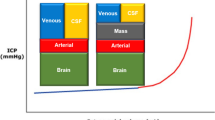Abstract
Introduction
Head injury is the leading cause of accidental death in children. Recent reports have shown the benefit of decompressive craniectomy in children and the role of early timing has been emphasized. However, there is still a lack of data to determine the optimal time for performing craniectomy.
Case report
In contrast to most reports in the literature, this case report demonstrates successful bilateral decompressive craniectomy in a 10-year-old girl with multiple posttraumatic intracranial lesions and massive traumatic brain swelling on the 8th posttraumatic day.
Conclusions
Various pathophysiological mechanisms in the genesis of posttraumatic brain swelling make different treatment strategies necessary. Continuous monitoring of intracranial pressure (ICP), as well as serial cranial computed tomography (CCT), can help to differentiate between these mechanisms. Furthermore, repeated clinical and neurophysiological investigations are important for the timing of craniectomy.

Similar content being viewed by others
References
Agrawal HC, Davis JM, Himwich WA (1968) Water content of dog brain parts in relation to maturation of the brain. Am J Physiol 215:846–848
Aldrich EP, Eisenberg HM, Saydjari C (1992) Diffuse brain swelling in severely head-injured children. J Neurosurg 76:450–453
Baba T, Black KL, Ikezaki K (1991) Intracarotid infusion of leukotriene C4 selectively increases blood–brain barrier permeability after focal ischemia in rats. J Cereb Blood Flow Metab 11:638–643
Baigas KV, Grundi PD, Kochanek PM, Schiding JK, Nemoto EM (1996) Posttraumatic hyperemia in immature, mature, and aged rats: autoradiographic determination of cerebral blood flow. J Neurotrauma 13:189–200
Bardt TF, Unterberg AW, Hartl R, Kiening KL, Schneider GH, Lanksch WR (1998) Monitoring of brain tissue PO2 in traumatic brain injury: effect of cerebral hypoxia on outcome. Acta Neurochir Suppl 71:153–156
Barie AJ, Ghajar JB, Firlik AD, Chang VA, Hariri RJ (1993) Contribution of increased cerebral blood volume to post traumatic intracranial hypertension. J Trauma 35:69–71
Beaumont A, Marmarou A (1999) Treatment of raised intracranial pressure following traumatic brain injury. Crit Rev Neurosurg 9:207–216
Bellander B-M, von Holst H, Fredman P (1996) Activation of the complement cascade and increase of clusterin in the brain following a cortical contusion in the adult rat. J Neurosurg 85:468–475
Bruce DA, Alavi A, Bilaniuk L (1981) Diffuse cerebral swelling following head injuries in children: the syndrome of “malignant brain edema.” J Neurosurg 54:170
Caley DW, Maxwell DS (1970) Development of the blood vessels and extracellular space during postnatal maturation of rat cerebral cortex. J Comp Neurol 138:31–48
Chan PH, Schmidley JW, Fishman RA (1984) Brain injury, edema and vascular permeability changes induced by oxygen-derived free radicals. Neurology 34:315–320
Dam Hieu P, Sizun J, Person H, Besson G (1996) The place of decompressive surgery in the treatment of uncontrollable post-traumatic intracranial hypertension in children. Childs Nerv Syst 12:270–275
Evans AN, Reynolds JM, Reynolds ML (1974) Development of a blood–brain barrier mechanism in foetal sheep. J Physiol 238:371–386
Graham D, Adam J, Doyle D, Lawrence A, McLellan D, Ng H (1989) Fatal head injury in children. J Clin Pathol 42:18–22
Hejazi N, Witzmann A, Fae P (2002) Unilateral decompressive craniectomy for children with severe brain injury. Report of seven cases and review of the relevant literature. Eur J Pediatr 161:99–104
Kita H, Marmarou A (1994) The cause of acute brain swelling after closed head injury in rats. Acta Neurochir Suppl (Wien) 60:452–455
Kjellberg RN, Prieto A Jr (1971) Bifrontal decompressive craniectomy for massive cerebral edema. J Neurosurg 34:488–493
Lang DA, Teasdale GM, Macpherson P, Lawrence A (1994) Diffuse brain swelling after head injury: more often malignant in adults than in children. J Neurosurg 80:675–680
McBride DQ, Shalmon E, Herman D, Becker DP (1997) Cerebral blood flow as a predictor of outcome following traumatic brain injury. J Neurosurg 86:633–641
McPherson K (1974) Statistics: the problem of examining accumulating data more than once. N Engl J Med 290:501–502
Miller JD (1992) Evaluation and treatment of head injury in adults. Neurosurg Q 2:28–43
Murgio A, Andrade FA, Sanchez Munoz MA, Boetto S, Leung KM (1999) International multicenter study of head injury in children. Childs Nerv Syst 15:318–321
Paolin A, Rodriguez G, Betetto M (1998) Cerebral hemodynamic response to CO2 after severe head injury: clinical and prognostic implications. J Trauma 44:495
Polin RS, Shaffrey ME, Boagaev CA, Tisdale N, Germanson T, Bocchicchio B, Jane JA (1997) Decompressive bifrontal craniectomy in the treatment of severe refractory posttraumatic cerebral edema. Neurosurgery 41:84–94
Rinaldi A, Mangiola C, Anile C, Maira G, Amante P, Ferraresi A (1990) Hemodynamic effects of decompressive craniectomy in cold induced brain oedema. Acta Neurochir Suppl 51:394–396
Sahuquillo J, Poca MA, Garnacho A (1993) Early ischemia after severe head injury. Preliminary results in patients with diffuse brain injuries. Acta Neurochir 122:204–214
Salvemini D, Wang Z-Q, Wyatt PS (1996) Nitric oxide: a key mediator in the early and late phase of carrageenan-induced rat paw inflammation. Br J Pharmacol 118:829–838
Tanno H, Nockels RP, Pitts LH (1992) Breakdown of the blood–brain barrier after fluid percussive brain injury in the rat. I. Distribution and time course of protein extravasation. J Neurotrauma 9:21–32
Taylor A, Butt W, Rosenfeld J, Shann F, Ditchfield M, Lewis E, Kulg G, Wallace D, Henning R, Tibballs J (2001) A randomized trial of very early decompressive craniectomy in children with traumatic brain injury and sustained intracranial hypertension. Childs Nerv Syst 17:154–162
Van Santbrink H, Maas A, Avezaat CJJ (1996) Continuous monitoring of partial pressure of brain tissue oxygen in patients with severe head injury. Neurosurgery 38:21–31
Venes JL, Collins WR (1975) Bifrontal decompressive craniectomy in the management of head trauma. J Neurosurg 42:429–433
Yoshino E, Yamaki T, Higuchi T, Horikawa Y, Hirakawa K (1985) Acute brain edema in fatal head injury: analysis by dynamic CT scanning. J Neurosurg 63:830–839
Author information
Authors and Affiliations
Corresponding author
Additional information
A commentary on this paper is available at http://dx.doi.org/10.1007/s00381-004-1045-9
Rights and permissions
About this article
Cite this article
Reithmeier, T., Speder, B., Pakos, P. et al. Delayed bilateral craniectomy for treatment of traumatic brain swelling in children: case report and review of the literature. Childs Nerv Syst 21, 249–253 (2005). https://doi.org/10.1007/s00381-004-1044-x
Received:
Revised:
Published:
Issue Date:
DOI: https://doi.org/10.1007/s00381-004-1044-x




